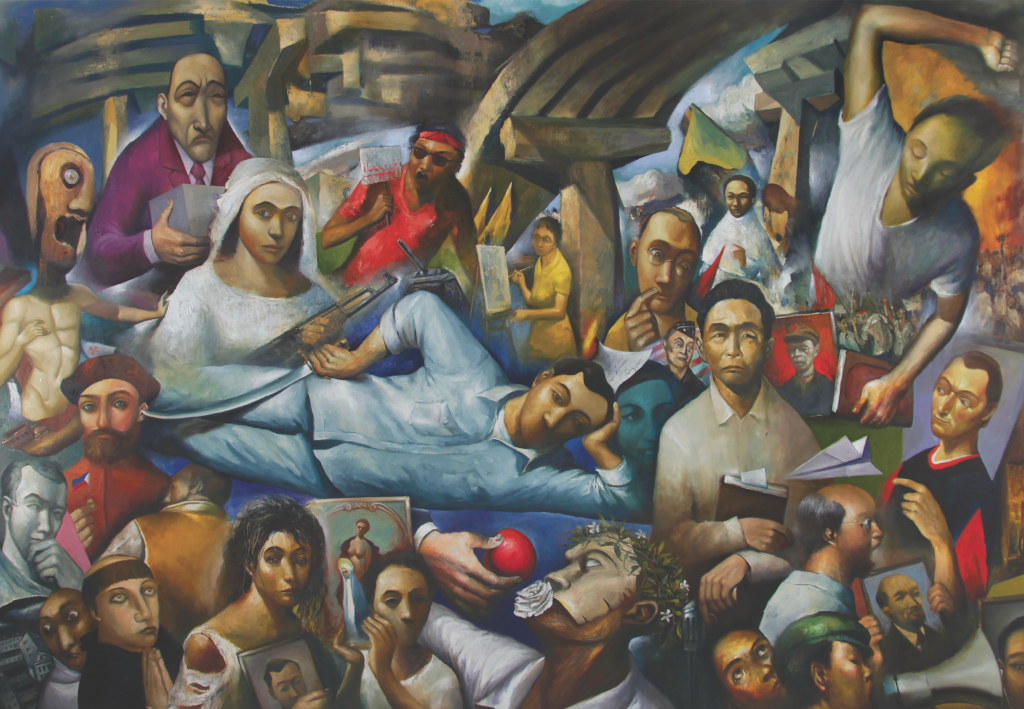LANSANGAN
Emmanuel Garibay
March 1 - 4, 2018

REAL CHANGE
Pictures of Men in Manny Garibay’s Lansangan
In 1987, correspondent for The Atlantic James Fallows wrote of the Philippines and its “Damaged Culture,” and how it could “make a naturally rich country poor.” Writing after EDSA – both the name of a major thoroughfare and shorthand for the bloodless revolution that has given Filipinos much pride – Fallows points out how the fall of dictator Ferdinand Marcos and the rise of Corazon Aquino represents not salvation, but “as the restoration of the old order.”
Whatever nuance Fallows adds to this discussion has since been aggressively distorted by the polarizing talk of the “dilawan” and “ka-DDS,” current slang for the labels given to the country’s ruling factions, and the subversion of the icons each one has used in its rise to power. The post-truth-post-facts environment in which we witnessed how the internet and social media can be weaponized to bring demagogues to power and revise history have since shifted our understanding of public space, turning our attention instead to other everyday facts of this avenue. Rather than see the layered historical narrative underpinning Epifanio Delos Santos Avenue, contemporary society sees it as a site of perpetual congestion, symbolic of our refusal, helplessness, and incapacity to move forward.
With paintbrush in hand, Emmanuel Garibay follows these turns of events as they unfold on the ground, the term “lansangan” or “street” referring to public space where diverse populations converge; but also referring to the EDSA revolution, and how it has gone from being celebrated as a historic moment where faith in democracy was restored, to just another sham holiday that further reinforces the authority of the landowning elite. Like many of his contemporaries in the collectives Salingpusa and Artista ng Bayan (ABAY), Garibay tries to tell the story of a society post-revolution through the faces and experiences of the Filipino everyman or “tao,” the nameless and largely faceless figures that populate our transient encounters. In any other democratic society, the tao is someone you come across in liminal spaces – on the train, on a bus, selling odds and ends at kiosks one would pass on the daily commute; in a word: a man on the street. Yet in Garibay’s renderings, it becomes further recognized what the street (in particular, the highway) have come to mean amidst failing infrastructure and increasing privatization, experienced through congested roads, long commutes, and dwindling options when it comes to affordable housing and public schooling. What Garibay describes through the motley cast of characters that make up Lansangan is how one road saddled with the baggage of history can tell a story about a society deprived of access to dignity.
The images are equally candid and tragic: a boy hunches over a basketball in a tableau that recalls Samuel Beckett’s Waiting for Godot; an androgynous figure (presumably a woman) negotiates with a police officer who in turn bears a weak grip on his baton while leaning on his riot shield; Kaisa (2018) has the viewer enduring hunger at mealtime with an emaciated and hazy-eyed laborer. In Lansangan (2018), the massive centerpiece of the show, Garibay depicts the actors and icons around whom this cycle of uprisings and inertia have come to revolt. Composed like a movie poster, Garibay paints a cast largely populated by male figures. A Rizal-like figure, lying on his side, looking smug with his head propped up on one hand and the other hand on his hip, dominates the foreground. Using the overpasses that criss-cross EDSA as a backdrop, we see a suggestion of a continuing journey and a way out, but we also feel the crushing weight of so much failed infrastructure and the incapacity or sheer incompetence at connecting with a deeply fractured society.
While a surface reading of the series would have the viewer thinking that through Lansangan, Garibay seeks to cast blame for our failures and shortcomings as a nation. Indeed, many of the works bear the wry humor of an editorial cartoon. Yet, rather than offering simple declarations of failure, Lansangan offers some redemption through the anonymity granted by Garibay’s brushwork. By looking past these seemingly cynical exercises of rendering political history through caricatures, Lansangan speaks of the cultural in the structural, reflecting upon how road, like a culture—damaged or otherwise—is built by men, and can therefore by undone by men as well.
One painting stands out, departing from the bleakness of all the rest: Daan (2018) shows a young boy sitting on the lap of his father as they cycle through a rural village scene. It is not the only painting depicting a father and son, but unlike the other works which paint bleak prospects for the patriarchy, Daan appears to illuminate a better path – one that actively chooses compassion and community. A long and arduous journey lies ahead, and by returning to the road as both metaphor and historic site, Garibay pulls together a series that both reflects on and critiques existing notions of revolution, action, and ideology.